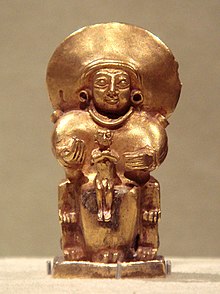Ḫannaḫanna
Ḫannaḫanna is a Hittite mother goddess who often appears in Hattic myths . Her name means "great grandmother" (from Hittite ḫanna- = grandmother). She was equated with the Mesopotamian mother goddess Dingirmaḫ .
Duties and veneration
As the mother goddess, Ḫannaḫanna also helped with childbirth. According to an obstetrical ritual, she did not have her own place of worship, but it was said that she chose humanity instead. However, she took an important position in the cult of Karums Kaneš .
In the myth
In a fragmentary myth, Ḫannaḫanna promises land and a man to the goddess Inara . This person could be Ḫupašiya from the Illuyanka myth.
In the myth of the disappearance of the god Telipinu, she advises the other gods on what to do to track down the disappeared god. In the end, after several unsuccessful attempts, she sends her helper, the bee, to find the missing Telipinu , which the bee succeeds in doing. In another myth, it disappears itself.
In the myth of the sea robbing the sun, the mother goddess mediates between Tarḫunna and the sea god regarding the bride price for Brautatepuna , the daughter of the sea, who was stolen by the god Telipinu in the course of the liberation of the sun.
In another myth, Ḫannaḫanna states that a poor man who sacrifices to the sun does not have to sacrifice as much with just one sheep as a rich man (nine sheep).
Other grandparent deities
Ḫannaḫanna is not the only grandparent deity in the Hittite pantheon.
So there is the grandfather god Ḫuḫḫa (Hittite ḫuḫḫa- = grandfather), the father of a weather god and grandfather of another weather god.
The grandmother goddess Ammamma (Hittite amma - possibly = mother) is also known. She is a goddess of nature and fertility.
See also
literature
- Gary M. Beckmann: Hittite Birth Rituals. (= Studies on the Boğazköy texts. 29). Harrassowitz 1983, ISBN 3-447-02310-4 .
- Volkert Haas : Die Hittitische Literatur ., Walter de Gruyter, Berlin 2006, ISBN 3-11-018877-5 .
- Volkert Haas, Heidemarie Koch: Religions of the ancient Orient: Hittites and Iran . Vandenhoeck & Ruprecht, Göttingen 2011, ISBN 978-3-525-51695-9 .
- Galina Kellermann: La deesse Ḫannaḫanna. In: Hethitica. Volume VII, 1987, ISBN 90-6831-081-X , pp. 93-107.
- Piotr Taracha : Religions of Second Millennium Anatolia . Harrassowitz Verlag, Göttingen / Wiesbaden 2009, ISBN 978-3-447-05885-8 .
Individual evidence
- ↑ a b c Volkert Haas, Heidemarie Koch: Religions of the ancient Orient: Hittites and Iran . Göttingen 2011, p. 224.
- ^ A b Piotr Taracha: Religions of Second Millennium Anatolia . Wiesbaden 2009, p. 125.
- ↑ Volkert Haas: The Hittite literature. Berlin 2006, p. 198.
- ^ Piotr Taracha: Religions of Second Millennium Anatolia . Wiesbaden 2009, p. 31.
- ↑ Volkert Haas: The Hittite literature. Berlin 2006, p. 97 f.
- ↑ Volkert Haas: The Hittite literature. Berlin 2006, p. 106 f.
- ^ Piotr Taracha: Religions of Second Millennium Anatolia . Wiesbaden 2009, p. 156.
- ↑ Volkert Haas: The Hittite literature. Berlin 2006, p. 116.
- ↑ Volkert Haas: The Hittite literature. Berlin 2006, p. 120.
- ^ Piotr Taracha: Religions of Second Millennium Anatolia . Wiesbaden 2009, p. 57.
